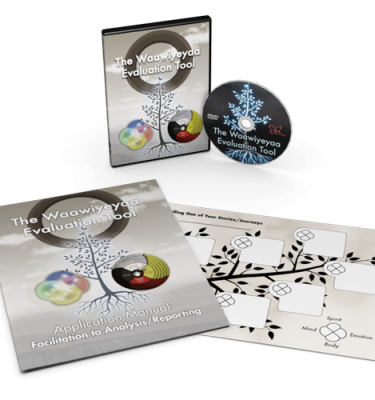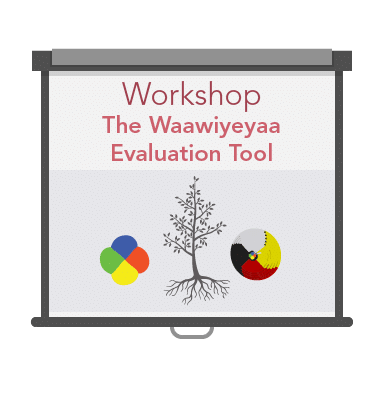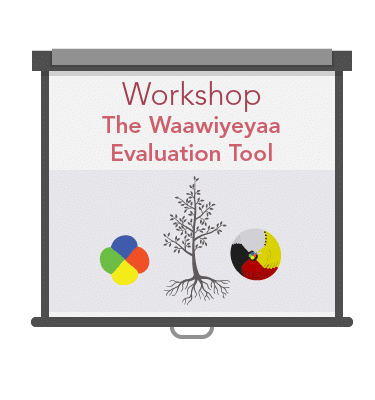A One-Day Workshop Providing a Complete Training Experience
Our in-house Indigenous evaluation tool enables evaluators to capture a qualitative storyboard utilizing a cultural-based learning video (available for download). The training supports you in experiencing the tool first-hand, learning how to analyze and report on the data and transform the storyboard into a quantitative database file which can track program impacts over time.
JRI has utilized this tool to evaluate healing, justice, health, addiction, employment, mental health, education, and cultural teaching programs. The tool’s development conversations were held with Indigenous evaluators, traditional healers, and Indigenous programs; in addition to comparisons to models of Indigenous healing journeys.
The Ojibway Word Waawiyeyaa Refers to a Circular Process that can Lead to Rebirth and Transformation. This is a journey one travels and through reflective thought and introspection a person is able to further travel around this circular path which always lead back to the start. When a person reaches the point at which they started, introspection can occur which can then lead to rebirth and transformation, as they travel around the circle again. Developed by Johnston Research Inc., this wholistic evaluation tool, grounded in Anishnawbe traditional knowledge, was created for use in culturally-appropriate programs for Aboriginal people seeking to make changes in their life. This self-evaluation tool provides a semi-structured process for recording program development and/or individual participant progress towards greater balance.
The Waawiyeyaa Evaluation Tool takes a completely alternative approach in its intervention-based approach. The Western definition of an intervention-based method is: promoting good health practices (which foster dependence on the medical-system), restoring skills (a narrow definition of job readiness), works to prevents disability and related problems (a deficit-based statement). A typical Western example is that a group of friends confront a friend on using drugs and ask their friend to seek treatment. However, an Indigenous definition, one that is applied using the Waawiyeyaa Evaluation Tool is that an intervention-based approach will Inspire transformation, impart knowledge, and provide evidence self-healing works in an easy to understand arts-based approach. For example, the implementation of the Waawiyeyaa Evaluation Tool can be observed to include: 1. Sharing Indigenous teachings, 2. learning a framework based upon Indigenous teachings that individuals can apply to their own selves and 3. providing tools that enable them to participate in self-evaluation whereby, the activity as a whole, 4. promotes good health and self-healing seamlessly.
In the Workshop We Will Examine:
Experiencing the Tool
In order to use the tool, one must experience and use the tool to explain his/her own story.
By using approaches grounded in Indigenous traditional values, we have found great success in meeting the needs of program participants and program personnel during the evaluation process. The Waawiyeyaa method encourages participants to move beyond the physical and uses traditional teachings as a framework for storytelling. A female and a male story are shared on the DVD movie, and can be used as a starting point for participants to begin telling their stories. During a group session or one-on-one, participants are asked to work within two frameworks to tell their stories: The Teaching of Self, which describes a person being comprised of four parts, the spirit, mind, emotion, and body, and the Teaching of the Tree of Life, which uses a metaphor that compares our lives to that of a tree as a pathway of our lives.
Reviewing Data Sets and Analysis
A powerful tool as a qualitative story or a quantitative measure that can illustrate change over time.
A participant would record their story during a paper and pencil crayon exercise. Participants appreciate and like the tool because the storytelling is driven by them, based on their perceptions, and at each person’s own pace. Program providers value the tool because it provides systematic, culture-based documentation of program and individual changes. Data are coded using a matrix of crises where standing tall is the ultimate target indicating a point of significant changes in one’s life. These coded data are then assigned a score whereby the qualitative measure is coded into a quantification that can track change over time. The story about the tree in the DVD movie suggests that as one expands their tool bundle and experiences challenges as one grows, the impacts will be less devastating or dramatic.
Reporting and Telling the Story
Telling the story from this exercise is rewarding because the stories are told in the participants own words.
The foundation of the stories is the Tree of Life teaching, which uses a metaphor that compares our lives to that of a tree, where the roots are strongly connected to Mother Earth and the top of the tree is a conduit to the Spirit World. Grounding the stories to a common structure allows for a more easily accomplished analysis of the program’s impacts and capabilities at different iterations of a program’s development. The report is a combination of ratings summaries from program participant examples and charts of progression over time, as well as a selection for quotes and complete stories to provide substance to the readers. Especially we hope that results from evaluations and research are shared back with the groups from which the data were originally gathered, in a meaningful oral and visual interactive format.
Who Should Attend and How You Will Benefit
What You Will Learn
- The Tool’s Rationale and its History
- Experience the tool – write-out your own stories
- What to do with the Data, Review of other Datasets
- Hands-on scoring, step-by-step
- Hands-on reporting, step-by-step
What Comes With the Workshop
- The full instructional digital video download
- The Waawiyeyaa Evaluation Tool manual
- Blank and example story sheets
Who This Workshop is For
- Western taught / based evaluators
- Program staff who work with Indigenous populations
- Government staff and management who manage programs directed to Indigenous peoples
- Non-government organizations who work with Indigenous peoples
- Students who are interested in evaluation and expanding their knowledge-base
We Can Come to You!
Interested in experiencing one of our workshops for your whole team?
We also provide on-site training for each of our modules right at your home office.



